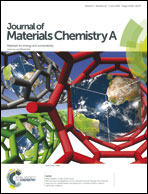Enhancing the performance of Li3VO4 by combining nanotechnology and surface carbon coating for lithium ion batteries
Abstract
With a large capacity and low voltage, Li3VO4 has recently attracted much attention as a new insertion-type anode material for lithium-ion batteries. However, the poor electronic conductivity of Li3VO4 leads to a large amount of inactive conduct agents in the electrode, which definitely sacrifice the electrode capacity and limit the rate performance. In this work, we propose a strategy in which Li3VO4 is first broken into nanometer scale particles by high energy ball milling to increase the active surface and shorten the Li+ diffusion distance, and then the particle surface was homogeneously coated with nanolayered carbon via a chemical vapor deposition (CVD) method for electronic conductivity enhancement. The obtained nanosized Li3VO4 is uniformly coated by ∼5 nm carbon layers. Compared to the untreated counterpart, the modified Li3VO4, dued to the synergetic effects of the nanometer scale and the carbon coating, exhibits an increased first Coulombic efficiency from 68.8% to 79.5%, a higher reversible capacity from 225 to 315 mA h g−1 and a superior rate performance. Importantly, the carbon-coated nanosized Li3VO4 with only 5% conductive additive exhibits better performances than the microsized raw Li3VO4 with 10% conductive additive, showing the important effects of particle size and electronic conductivity on the electrochemical properties of Li3VO4.


 Please wait while we load your content...
Please wait while we load your content...